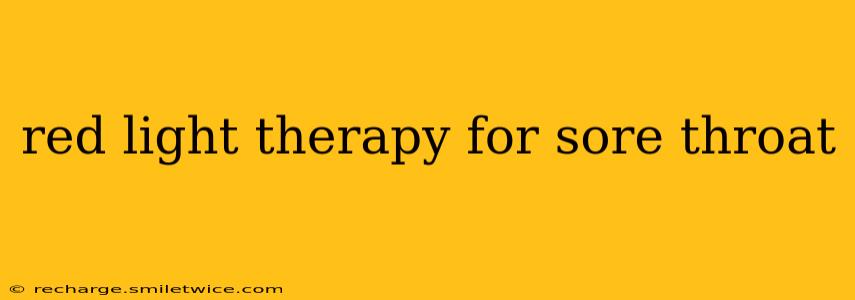A sore throat, that scratchy, painful discomfort, is a common ailment often caused by viral or bacterial infections, allergies, or even dry air. While rest and hydration are crucial, many are exploring alternative therapies like red light therapy (RLT) for relief. But does it actually work for sore throats? Let's delve into the science and explore the potential benefits and limitations.
What is Red Light Therapy?
Red light therapy, also known as low-level laser therapy (LLLT), uses low-wavelength red and near-infrared light to penetrate the skin and stimulate cellular processes. This stimulation is believed to reduce inflammation, promote tissue repair, and alleviate pain. The wavelengths used typically fall between 630 and 850 nanometers. While widely used for various skin conditions, its application to sore throats is less extensively researched.
Can Red Light Therapy Help with a Sore Throat?
The effectiveness of red light therapy for sore throats isn't definitively proven through large-scale clinical trials. However, the underlying mechanisms suggest potential benefits. RLT's anti-inflammatory properties could help reduce swelling in the throat, potentially alleviating pain and discomfort. Furthermore, the improved cellular function could speed up the healing process.
However, it's crucial to understand that RLT isn't a cure-all. It's likely most effective as a supportive therapy alongside conventional treatments like rest, hydration, and over-the-counter pain relievers. For severe or persistent sore throats, seeking medical advice is essential.
How to Use Red Light Therapy for a Sore Throat (If Choosing To Do So)
If you decide to try RLT for your sore throat, it's important to do so safely and correctly. There aren't established protocols for sore throats specifically. However, the general approach involves directing the light towards the neck area, focusing on the throat region. Consult the manufacturer's instructions for your specific device regarding treatment duration and intensity. Remember that excessive exposure can be harmful.
Does Red Light Therapy Kill Bacteria Causing Sore Throats?
This is a common question. While RLT may reduce inflammation and support healing, it's not a direct antimicrobial treatment. It doesn't kill bacteria or viruses causing the sore throat. If your sore throat is bacterial in origin, antibiotics prescribed by a doctor are usually necessary.
What are the Side Effects of Red Light Therapy for Sore Throats?
Generally, red light therapy is considered safe, with minimal side effects. However, some individuals may experience mild skin redness or warmth in the treated area. Severe side effects are rare but can include eye damage if not properly protected during treatment. Always follow manufacturer guidelines and wear appropriate eye protection.
Is Red Light Therapy Better Than Other Sore Throat Treatments?
RLT shouldn't be considered a replacement for established sore throat treatments. It may offer additional relief, particularly in reducing inflammation and pain, but it’s not a standalone cure. Rest, fluids, gargling with salt water, and over-the-counter pain relievers remain the cornerstone of effective sore throat management. Antibiotics are necessary for bacterial infections.
When Should I See a Doctor for a Sore Throat?
While many sore throats resolve on their own, you should consult a doctor if:
- Your sore throat lasts longer than a week.
- You have difficulty swallowing or breathing.
- You have a high fever (over 101°F or 38.3°C).
- You have swollen glands in your neck.
- You have a rash.
- You experience severe pain.
Red light therapy might offer additional comfort, but it's crucial to prioritize proper medical evaluation and treatment for persistent or severe sore throats. This information is for general knowledge and shouldn't be considered medical advice. Always consult a healthcare professional for diagnosis and treatment.
